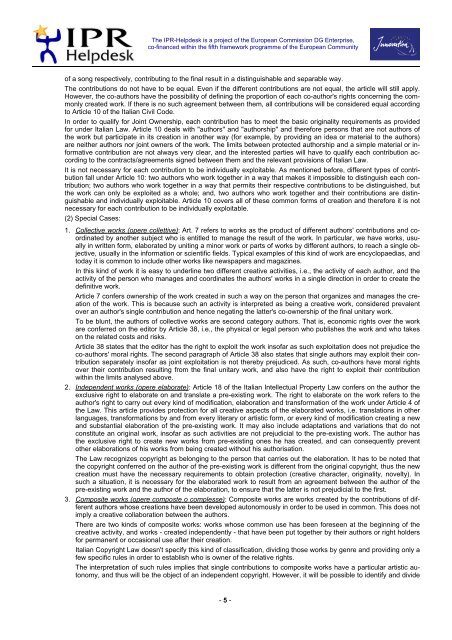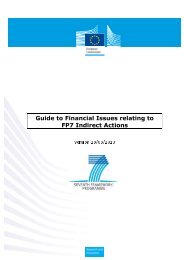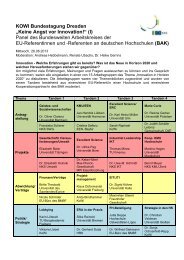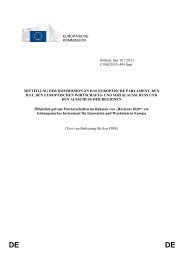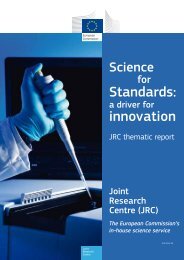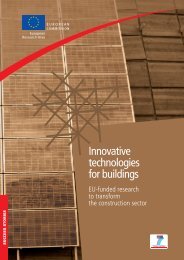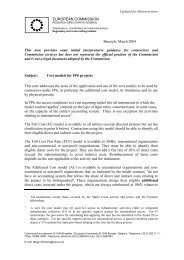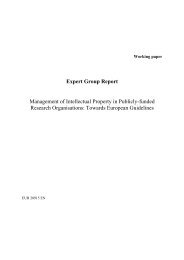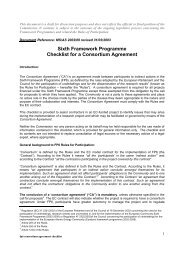Joint Ownership in Intellectual Property Rights - KoWi
Joint Ownership in Intellectual Property Rights - KoWi
Joint Ownership in Intellectual Property Rights - KoWi
You also want an ePaper? Increase the reach of your titles
YUMPU automatically turns print PDFs into web optimized ePapers that Google loves.
The IPR-Helpdesk is a project of the European Commission DG Enterprise,<br />
co-f<strong>in</strong>anced with<strong>in</strong> the fifth framework programme of the European Community<br />
of a song respectively, contribut<strong>in</strong>g to the f<strong>in</strong>al result <strong>in</strong> a dist<strong>in</strong>guishable and separable way.<br />
The contributions do not have to be equal. Even if the different contributions are not equal, the article will still apply.<br />
However, the co-authors have the possibility of def<strong>in</strong><strong>in</strong>g the proportion of each co-author's rights concern<strong>in</strong>g the commonly<br />
created work. If there is no such agreement between them, all contributions will be considered equal accord<strong>in</strong>g<br />
to Article 10 of the Italian Civil Code.<br />
In order to qualify for <strong>Jo<strong>in</strong>t</strong> <strong>Ownership</strong>, each contribution has to meet the basic orig<strong>in</strong>ality requirements as provided<br />
for under Italian Law. Article 10 deals with "authors" and "authorship" and therefore persons that are not authors of<br />
the work but participate <strong>in</strong> its creation <strong>in</strong> another way (for example, by provid<strong>in</strong>g an idea or material to the authors)<br />
are neither authors nor jo<strong>in</strong>t owners of the work. The limits between protected authorship and a simple material or <strong>in</strong>formative<br />
contribution are not always very clear, and the <strong>in</strong>terested parties will have to qualify each contribution accord<strong>in</strong>g<br />
to the contracts/agreements signed between them and the relevant provisions of Italian Law.<br />
It is not necessary for each contribution to be <strong>in</strong>dividually exploitable. As mentioned before, different types of contribution<br />
fall under Article 10: two authors who work together <strong>in</strong> a way that makes it impossible to dist<strong>in</strong>guish each contribution;<br />
two authors who work together <strong>in</strong> a way that permits their respective contributions to be dist<strong>in</strong>guished, but<br />
the work can only be exploited as a whole; and, two authors who work together and their contributions are dist<strong>in</strong>guishable<br />
and <strong>in</strong>dividually exploitable. Article 10 covers all of these common forms of creation and therefore it is not<br />
necessary for each contribution to be <strong>in</strong>dividually exploitable.<br />
(2) Special Cases:<br />
1. Collective works (opere collettive): Art. 7 refers to works as the product of different authors' contributions and coord<strong>in</strong>ated<br />
by another subject who is entitled to manage the result of the work. In particular, we have works, usually<br />
<strong>in</strong> written form, elaborated by unit<strong>in</strong>g a m<strong>in</strong>or work or parts of works by different authors, to reach a s<strong>in</strong>gle objective,<br />
usually <strong>in</strong> the <strong>in</strong>formation or scientific fields. Typical examples of this k<strong>in</strong>d of work are encyclopaedias, and<br />
today it is common to <strong>in</strong>clude other works like newspapers and magaz<strong>in</strong>es.<br />
In this k<strong>in</strong>d of work it is easy to underl<strong>in</strong>e two different creative activities, i.e., the activity of each author, and the<br />
activity of the person who manages and coord<strong>in</strong>ates the authors' works <strong>in</strong> a s<strong>in</strong>gle direction <strong>in</strong> order to create the<br />
def<strong>in</strong>itive work.<br />
Article 7 confers ownership of the work created <strong>in</strong> such a way on the person that organizes and manages the creation<br />
of the work. This is because such an activity is <strong>in</strong>terpreted as be<strong>in</strong>g a creative work, considered prevalent<br />
over an author's s<strong>in</strong>gle contribution and hence negat<strong>in</strong>g the latter's co-ownership of the f<strong>in</strong>al unitary work.<br />
To be blunt, the authors of collective works are second category authors. That is, economic rights over the work<br />
are conferred on the editor by Article 38, i.e., the physical or legal person who publishes the work and who takes<br />
on the related costs and risks.<br />
Article 38 states that the editor has the right to exploit the work <strong>in</strong>sofar as such exploitation does not prejudice the<br />
co-authors' moral rights. The second paragraph of Article 38 also states that s<strong>in</strong>gle authors may exploit their contribution<br />
separately <strong>in</strong>sofar as jo<strong>in</strong>t exploitation is not thereby prejudiced. As such, co-authors have moral rights<br />
over their contribution result<strong>in</strong>g from the f<strong>in</strong>al unitary work, and also have the right to exploit their contribution<br />
with<strong>in</strong> the limits analysed above.<br />
2. Independent works (opere elaborate): Article 18 of the Italian <strong>Intellectual</strong> <strong>Property</strong> Law confers on the author the<br />
exclusive right to elaborate on and translate a pre-exist<strong>in</strong>g work. The right to elaborate on the work refers to the<br />
author's right to carry out every k<strong>in</strong>d of modification, elaboration and transformation of the work under Article 4 of<br />
the Law. This article provides protection for all creative aspects of the elaborated works, i.e. translations <strong>in</strong> other<br />
languages, transformations by and from every literary or artistic form, or every k<strong>in</strong>d of modification creat<strong>in</strong>g a new<br />
and substantial elaboration of the pre-exist<strong>in</strong>g work. It may also <strong>in</strong>clude adaptations and variations that do not<br />
constitute an orig<strong>in</strong>al work, <strong>in</strong>sofar as such activities are not prejudicial to the pre-exist<strong>in</strong>g work. The author has<br />
the exclusive right to create new works from pre-exist<strong>in</strong>g ones he has created, and can consequently prevent<br />
other elaborations of his works from be<strong>in</strong>g created without his authorisation.<br />
The Law recognizes copyright as belong<strong>in</strong>g to the person that carries out the elaboration. It has to be noted that<br />
the copyright conferred on the author of the pre-exist<strong>in</strong>g work is different from the orig<strong>in</strong>al copyright, thus the new<br />
creation must have the necessary requirements to obta<strong>in</strong> protection (creative character, orig<strong>in</strong>ality, novelty). In<br />
such a situation, it is necessary for the elaborated work to result from an agreement between the author of the<br />
pre-exist<strong>in</strong>g work and the author of the elaboration, to ensure that the latter is not prejudicial to the first.<br />
3. Composite works (opere composte o complesse): Composite works are works created by the contributions of different<br />
authors whose creations have been developed autonomously <strong>in</strong> order to be used <strong>in</strong> common. This does not<br />
imply a creative collaboration between the authors.<br />
There are two k<strong>in</strong>ds of composite works: works whose common use has been foreseen at the beg<strong>in</strong>n<strong>in</strong>g of the<br />
creative activity, and works - created <strong>in</strong>dependently - that have been put together by their authors or right holders<br />
for permanent or occasional use after their creation.<br />
Italian Copyright Law doesn't specify this k<strong>in</strong>d of classification, divid<strong>in</strong>g those works by genre and provid<strong>in</strong>g only a<br />
few specific rules <strong>in</strong> order to establish who is owner of the relative rights.<br />
The <strong>in</strong>terpretation of such rules implies that s<strong>in</strong>gle contributions to composite works have a particular artistic autonomy,<br />
and thus will be the object of an <strong>in</strong>dependent copyright. However, it will be possible to identify and divide<br />
- 5 -


